Top Stories in Digital Marketing for the First Quarter of 2021
Author & Editor
Content Team Lead
Published on: Mar 12, 2021 Updated on: May 17, 2024

Table of Contents
Just because most of us were indoors in 2020 doesn’t mean the digital marketing world had to be uneventful and silent. In fact, a lot of developments and major improvements have taken place since the lockdown started.
It took a global pandemic to give brands and marketers the “push” they needed to adopt digital strategies if they wanted to keep their businesses afloat. But engaging digital comes with the responsibility of being knowledgeable in the latest trends and news on a myriad of digital disciplines such as SEO, Content, PPC, and Social Media Marketing, to name a few. It’s a fast-paced world that can change in the blink of an eye, after all.
To help you keep up and stay updated on all things digital, let Propelrr give you a round-up of the most groundbreaking news in the digiverse for the first quarter of 2021.
Digital Marketing & Tech
The Future of AI in Marketing this 2021 and Beyond
Artificial Intelligence (AI) has indeed come a long way, changing the very fabric of the future as we see it. Today, a lot of companies are capitalizing their AI capabilities on their B2C and B2B marketing and sales efforts. This has enabled them to deliver business-driven insights through big-data computations that seemed humanly impossible in the past decades.
But just what are the exact implications of AI in marketing this 2021 and beyond? For starters, in 2020 alone marketers’ use of AI has spiked to 84% from 29% in 2018. This implies the growing demand of digital marketing agencies to adopt machine learning and AI technologies to their strategies in the years to come.
Add to that, as user interaction becomes more digital, consumer data is exponentially increasing to a point that it requires high-level business computations to improve marketing performance. Safe to say, today’s marketing efforts evolved to a certain degree of dependence on AI to improve campaign performance and conversion tracking.
Why should you care?
AI has certainly reached a pivotal role in digital marketing when it comes to crunching data that matters for a well-informed strategy-execution. Marketing agencies and brands alike need to be aware of the current state of AI in 2021 and beyond to recognize its impact and adapt the component in your marketing mix before it’s too late.
AI is making big waves in providing tools that impact your Customer Relationship Management (CRM) and Customer Data Platform (CDP) systems through marketing automation software. Don’t take for granted this opportunity and stay informed with the latest marketing updates in the world of AI.
Key points to remember
Regardless of its rapid development in the digital marketing sphere, here are practical ways to adopt AI in your business' daily operations. Learning AI shouldn’t be intimidating for you, and it’s better to engage your brand in this field now before your competitors can gain the upper hand on digital.
However, it’s important to keep in mind the current AI challenges for digital marketers in 2021 to help prepare your brand in the best possible way when adopting AI tools into your marketing strategy.
Ultimately, the intent of AI is to provide your brand with customer insights such as predictive analytics that can help power up your top-level decision-making for a more conversion-focused approach in your digital strategies.
SEO
All Google Core Web Vitals must be met for ranking boost
Google announced that the minimum threshold for all Core Web Vitals must be met to benefit from the latest ranking signal.
Core Web Vitals is the latest ranking signal the Google Algorithm will use come 2021. As Google’s announcement puts it, Core Web Vitals is meant to “measure how users perceive the experience of interacting with a web page and contribute to our ongoing work to ensure people get the most helpful and enjoyable experiences from the web.”
These page experience metrics that Google is referring to consists of:
- Largest Contentful Paint (LCP): Measures the speed at which a page’s main content is loaded. This should occur within 2.5 seconds of landing on a page.
- First Input Delay (FID): Measures the speed at which users are able to interact with a page after landing on it. This should occur within 100 milliseconds.
- Cumulative Layout Shift (CLS): Measures how often users experience unexpected layout shifts. Pages should maintain a CLS of less than 0.1.
Google offers 6 different ways of measuring Core Web Vitals. As we learn from John Mueller, Senior Webmaster Trends Analyst from Google, all minimum requirements need to be met to benefit in terms of ranking from the upcoming algorithm update.
Why should you care?
Come May 2021, Core Web Vitals will have a big impact in terms of your website’s ranking on Google.
Knowing this big of an update will help you evaluate your website according to the Core Web Vitals’ metrics and see what improvements you need to be prepared for the roll-out.
You can always get in touch with an SEO consultant if you need advice or assistance about the topic.
Key points to remember
While the update may be daunting, especially once it rolls-out, take note that if you’re providing quality and pleasant user experience to users — you’re all good and you don’t need to worry as much.
But if you want to be sure you won’t sink come D-day, best to check on your performance on the following and ask yourself these questions:
- Is my page speed optimized?
- How fast is it interactive?
- How fast is it stable?
- How’s my website speed on both desktop and mobile?
Things like that matter in the update. We advise you to read our page speed optimization guide to get a head start on speeding up your website performance.
For other updates and optimizations, best to check out the most recent Core Web Vital updates from Search Engine Journal:
- Google: All Core Web Vitals May Need to Be Met For Ranking Boost
- Google On Expected Impact of Core Web Vitals Update
- Mueller Discusses Site Traffic and Core Web Vitals
New engagement metrics on Google Analytics
GA4, the latest version of Google Analytics has retired ‘Bounce Rate’ and replaced it with ‘Engagement Rate’ which includes specific metrics like:
- Engagement Rate = (engaged sessions) / (sessions)
- Engaged Sessions per User = (engaged sessions) / (users)
- Engagement Time = sum(engagement time)
What is an ‘engaged session’?
GA4 has replaced the concept of “bounce” with “engaged sessions.” To be considered “engaged,” a session must either result in a conversion, last over 10 seconds, or have multiple screen or page views.
How different is ‘engaged session’ with ‘bounce rate’?
The main similarity between Engagement Rate and Bounce Rate is that they answer your concern of: “Are customers really engaged with my site?”
The key differences are:
- Engagement Rate can be applied to mobile apps, single-page apps, and content sites such as blogs and news outlets.
- Your Engagement Rate will always be greater than your Bounce Rate since a session with at least 2 page views (not a bounce) qualifies as an ‘engaged session’, but so do other sessions that would otherwise be considered a bounce.
Why should you care?
You should care about this especially if your Google Analytics is already GA4 as this is a better way to understand your website’s performance, especially on the user engagement front. This is also your sign to bid ‘bounce rate’ goodbye and focus more on user engagement and experience.
Key points to remember
Don’t be discouraged, think of this as an upgrade to bounce rate!
While many digital marketers are so used to ‘bounce rate’ and that learning a new metric will take time, think of it as a better way to understand and improve your website’s performance that is more user- and engagement-focused.
Read more about the new engagement metric from Logan Mastrianna or Ken Williams.
Search Featured Snippets Drop for Medical and Finance Sites
MozCast, the popular all-in-one SEO software suite, reported on February 19 the lowest drop (40% day-over-day) in Featured Snippets under the Finance and Healthcare sector, or Your Money Your Life sites.
Competitive healthcare terms like “diabetes,” “lupus,” “autism,” and “acne are reported to have lost two-thirds of their Featured Snippets. While the Finance sector experienced a big loss in high-search volume keywords like “pension,” “risk management,” “mutual funds,” and “investment.”
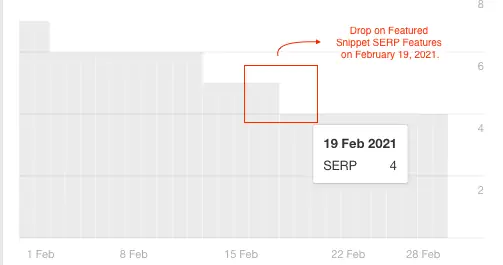
The screenshot is taken from Ahrefs from a Financial website.
The cause of the drop is unknown, but Moz Marketing scientist Dr. Peter J. Meyers noted that the loss may be a result of Google refining their algorithm to keep search intent more aligned and provide better answers to searchers in YMYL topics as these "...could potentially impact a person’s future happiness, health, financial stability, or safety."
Why should you care?
If your business websites fall under the Your Money, Your Life category such as e-commerce health and medical, news, or financial management or insurance sites, then you should be concerned.
Loss of these Featured Snippets can have a ripple effect in your Search Performance such as Average Position and even your overall Click-Through Rate. These affected metrics can also mean Organic Traffic from Search may decrease as your page or content is no longer on Rank Zero or covers wide Search Real Estate such as this one:
Key points to remember
While the drop is real (we’ve seen it for ourselves), the impact was primarily on shorter, more competitive head terms, and specific industry categories like those mentioned above.
We advise you to check your Search Performance via Google Search Console and compare it with at least 3 to 6 months' worth of data to see if your website has been affected. Once you notice a drop during February 19 to 20, investigate further into what keywords your Position or Clicks dropped the most — those are your most affected keywords or topics.
While there is no news of recovery yet, what you can do is:
- Evaluate the pages that lost Impressions, Positions, and Clicks and determine if it’s up to the Google Search Quality Standards or E-A-T. If not, time for an update!
- Bank on long-tail keywords more. Yes, they may have lower search volume but answering those niche-specific queries can get you back on lost Featured Snippets.
- Focus on content that has higher impressions, clicks, and sessions and benchmark for future blog content and articles.
Read more about this big drop in Featured Snippets over at Moz.
Content Marketing
Content Experiences is What’s New in Content Marketing
Content Experience, a term Rand Fishkin (the originator of 10X Content) coined, is the intersection between content marketing and user experience — focusing on structuring, packaging, and leveraging your content in the best possible way.
Content experience involves the following elements:
- The environment in which your content lives or is housed in;
- How your content is structured; and
- How your content compels your prospects and customers to engage with your company.
Using this approach will take content production to a large scale and find creative ways to repackage and upgrade your content for better performance and return on investment.
Why should you care?
If you’re regularly publishing content or have a content marketing strategy in place, using this strategic approach to the mix will make your audience consume and discover your content easier and encourage engagement and eventually turn into conversions for your business in the long run.
Plus, it allows you and your team to be creative with your content to stand out as a brand! You can even build trust and generate new leads, or conversions from your content.
Key points to remember
Regularly churning out content can take a toll on creativity that we tend to forget that it needs to elicit good and positive emotions in people for us to be trusted as a source of information and as a service provider.
Explore different content formats and styles! Be bold in your statements and don’t be afraid to let your brand’s personality shine in your content.
Remember: your content should be an experience that your readers must enjoy and ultimately, never forget. Who knows, your next reader may just be your next customer!
Learn more about content experience from Viola Eva of Search Engine Journal.
YouTube launches hashtag landing pages, allowing more categorized viewing of content
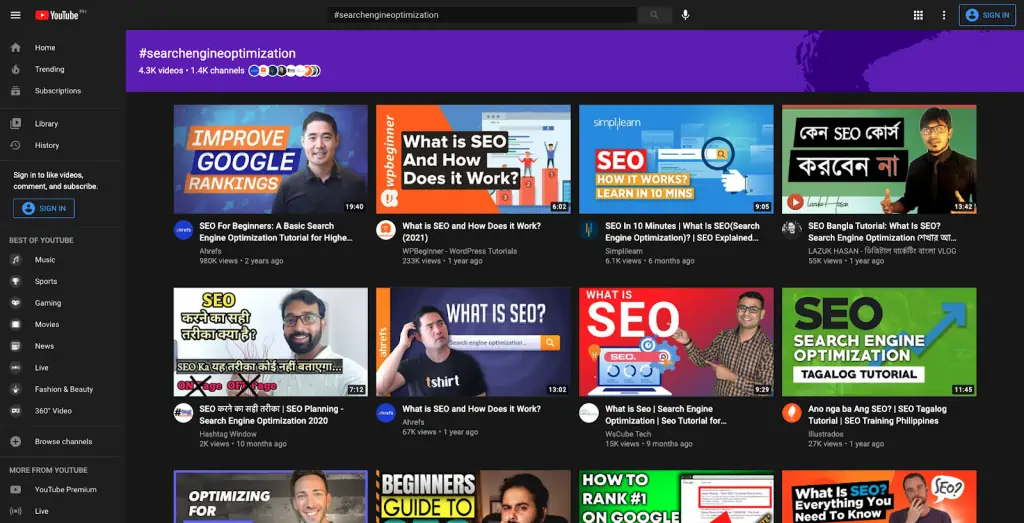
Screenshot from YouTube.
Leading platform in video content delivery YouTube finally embraces the hashtag so both users and creators are more able to organize the content they see and publish, respectively.
Although not the most groundbreaking innovation as hashtags have been existing on the internet since time immemorial, it still serves as a refreshing way of exploring content on the platform. Hashtags, as you may know well, are used in about every social media platform, most notably X and Instagram, to organize posts under one dedicated page.
Full details of the YouTube hashtag landing page update can be read on Tech Crunch’s website.
Why Should You Care?
YouTube’s hashtags timeline simply makes available to their creators and audiences this ability that has long been missing from the platform and is more of a delight rather than a cause for alarm.
Hashtags allow the indexing of content posted on social media platforms so they can be viewed on a dedicated public landing page for the viewing of all users – irrespective of whether they follow a publisher’s account or not. This means that you can further widen your reach on the platform even if you haven’t reached your target amount of subscribers, or if you don’t really have enough budget for YouTube Ads.
This new capability makes content discovery fair game between the biggest and smallest of channels – as long as they’re meeting the right metrics as well, of course.
Key points to remember
This update is one that you should really take advantage of if you’re looking for more views despite a small subscriber base or viewership.
However, this doesn’t mean that you should be spamming your content with every hashtag you can think of. The likelihood that your thumbnail gets clicked still boils down to whether your video is relevant to the topic of the hashtag a user is searching under.
Social Media Marketing
Facebook puts more focus on Follows with new public figure page layout

Screenshot from former Miss Universe Philippines Catriona Gray’s Facebook page.
With the total removal of the Like button at the top of the Facebook page of a public figure, the social media giant hopes to get users to pay more attention to and click the Follow button.
By following a page, users receive alerts on new posts from a page straight into their notifications list. More importantly, the lesser importance put on Likes hopes to instigate more engagements that result in conversations and feedback loops – an arguably better gauge of personal investment – between page owners and audiences.
Read the full article from Social Media Today if you wish to learn more about this news update.
Why Should You Care?
The value of the Like as a social media metric has long been questioned by digital marketers because it doesn’t really bring you or your business a lot of concrete results. In fact, it’s even more referred to as a ‘vanity metric’, or an inaccurate measure of popularity rather than performance.
This means that you should really ban the obsession with raking in Likes because those ad objectives don’t exist in this newer (hopefully) more engaged Facebook world.
Instead, focus your efforts on encouraging your audiences to hit the Follow button so that they don’t miss out on updates from your page. It’s also more important than ever to focus your efforts on sparking conversations and community management. This is because the benefits you get from these outweigh what you get from a Like in many aspects like cost-efficiency and increased conversions to name a few.
Key points to remember
This doesn’t mean that the Like is totally rendered invaluable. Given how Facebook’s News Feed algorithm works, Likes still help give your posts a boost in terms of visibility. That said, you should still count those Likes, but not as an ultimate measure of effectiveness.
X allows advertisers to control who can reply to promoted Tweets
Following a rollout of restricted replies to tweets from regular users, X extends the same capability to advertisers with their promoted tweets. This is a move widely seen as an effort to prevent unwanted dialogue – mostly concerning ‘trolls’ under these tweets.
For more details on the X update, you can read through this story published by Tech Centry.
Why Should You Care?
Advertising for increased awareness on social media always runs the risk of getting taken out of context and flopping in ways even the best of marketers weren’t able to anticipate.
This is almost always what happens when trolls find their way into threaded replies of promoted tweets or comments sections of other posts. Here, they’ll do their work of spreading information that may present as a negating case against brands or businesses – muddling the brand-consumer conversations that you may want to initiate.
While this purpose is not one explicitly communicated by X, it can be assumed by any internet native who’s encountered trolls on the platforms they are active. This new update provides an additional protective measure against these kinds of incidents and helps your customers and your business engage in healthy discussions about your products and/or services.
Key points to remember
When making use of Conversation Settings in your promoted tweets take time to assess your brand image and how your audiences perceive your business’s trustworthiness. If unsure, a general rule of thumb you can’t go wrong with is just allowing room to accept feedback, be they good or bad. That’s always a better move than shying away from open dialogue.
TikTok creates a new avenue to engage with audiences via Q&A Feature
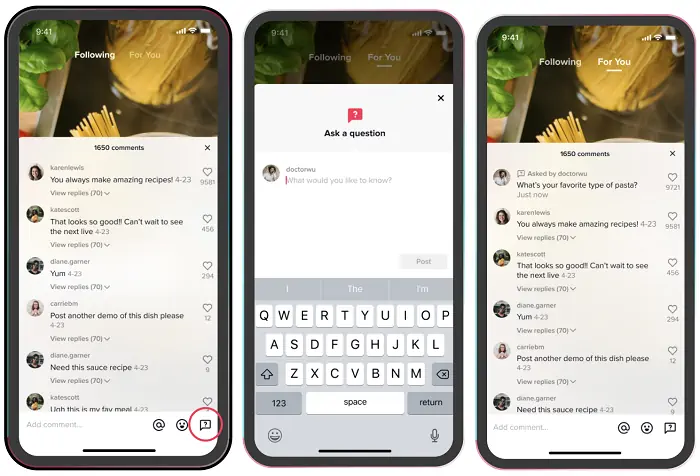
Photo courtesy of TikTok.
With the new feature, audiences of creators can easily post comments as questions that, in turn, the content creator can easily identify as comments that they should answer.
The rollout of this new capability, according to TikTok, is their way of “making it easier than ever for people to engage.”
Why Should You Care?
There are many ways that the pandemic has changed influencer marketing. One massive impact it has had is the way audiences seek authentic and genuine content more than ever and they measure this by how willing influencers are to engage with their audiences.
If you’re a brand that’s currently working or is looking to work with a social media influencer, this is one thing that you shouldn’t neglect to consider. TikTok rolled out this update to reduce communication hurdles for influencers; engagement should be their key metrics for performance as much as it is for your business.
Key points to remember
Customer engagement sounds like the easiest thing to do, but bear in mind that the air of authenticity is still a key factor in creating that connection. Audiences of these content creators follow them exactly for that reason.
When partnering with an influencer for a Q&A campaign to get to know your brand through them, for example, allow them to have creative freedom in terms of responding to their audiences. Provide them with guidelines of things they are allowed or not allowed to disclose about your campaign and/or brand, but resist controlling their tone so that their voice can remain as authentic as possible.
'LinkedIn Marketing Labs' makes learning about the platform's ad tools more accessible
A host of learning modules made available through LinkedIn Marketing Labs provides marketers a comprehensive guide to maneuvering LinkedIn ads.
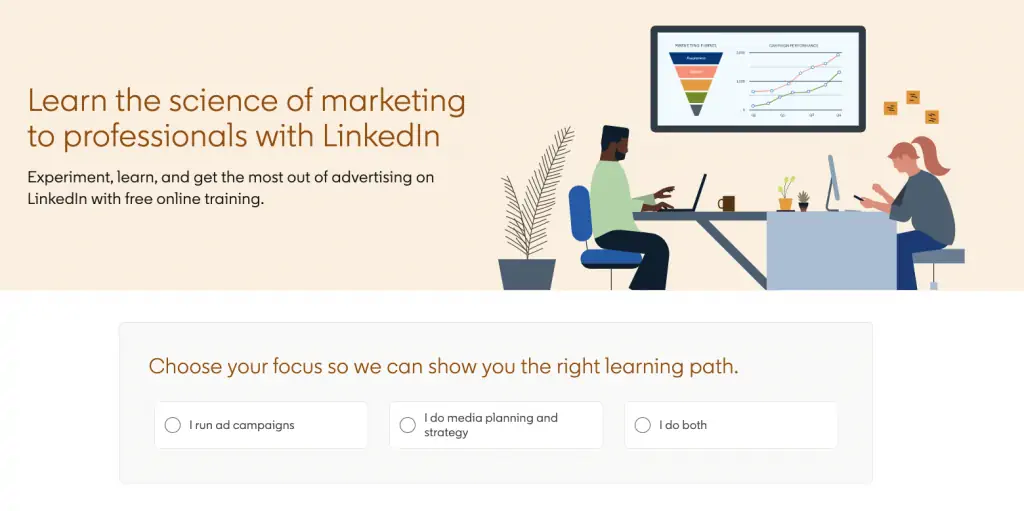
Screenshot from LinkedIn.
According to LinkedIn, the modules curated by in-house experts promise to learn about the best practices of using LinkedIn Ads to reach a diverse audience, across any industry.
An overview of the modules in LinkedIn Marketing Labs can be found in this news update from Social Media Today.
Why Should You Care?
Hailed as one of the best platforms for B2B networking, learning the ropes of LinkedIn Ads gives marketers in this field an edge over competitors who have yet to explore the platform’s ad services.
Make sure to invest in the training of your people in this regard through Marketing Labs, not only to benefit you during the pandemic but also beyond that.
Key points to remember
As with any digital marketing tool like LinkedIn Ads, training is important in developing only a fundamental understanding of how to operate them. How well you make use of it and how much you can make out of it will still depend mostly on your strategies.
Think back to your objectives, assess your strategies and see first how this fits into your marketing and overall business goals so that you’re not wasting resources.
Pay-per-click (PPC)
Facebook ads face limited visibility following Apple’s iOS 14 security update
Apple introduces an update with iOS 14 that enables users to opt-out of tailored ads from app developers marketing on the Apple Store. Facebook, among other developers, was expected to feel the brunt of the blow.
Why Should You Care?
What this simply entails is that you’re not getting in-depth and detailed information about where your conversions are coming from, on top of decreased efficiency in ad delivery and others. Our guide on what to expect from the iOS 14 update should provide you with sufficient information on how to manage it.
From a general point of view, the bottom line you should focus on is: You shouldn’t put all your eggs in one basket. For businesses whose marketing efforts are mostly concentrated on Facebook, this update comes as your signal to redirect or evenly distribute efforts across other viable channels.
A quick actionable solution you can take is to reassess what purpose Facebook marketing serves in your channel mix and identify an alternative platform that can similarly provide that benefit. Explore other channels like X and Instagram, or perhaps Tiktok and YouTube.
Key points to remember
This update may start to sound like you should pack up your Facebook advertising efforts, but given its massive user base, this is simply not an option especially for small businesses.
While yes, it is a big inconvenience, you should also consider the fact that there are still users who would rather have tailored ads and therefore opt-in to data tracking instead of having random ads just flash on their mobile phones or browsing windows.
Additionally, your business should take this more as an opportunity to inspect your marketing efforts for quality of audience targeting, and getting to know your market better. Remember that a tool is still subject to the will of the user.
Google phases out broad match as phrase match includes broad match modifier traffic
Search results that are targeted by broad match keywords will now turn up as results for phrase match as well. This, according to Google, was done because it has been shown that “phrase match and broad match modifier often serve the same use cases.”
They also added that with the combined use of both advertisers “can reach more of the right customers.”
More details on the update’s rollout can be read on Search Engine Land’s published report.
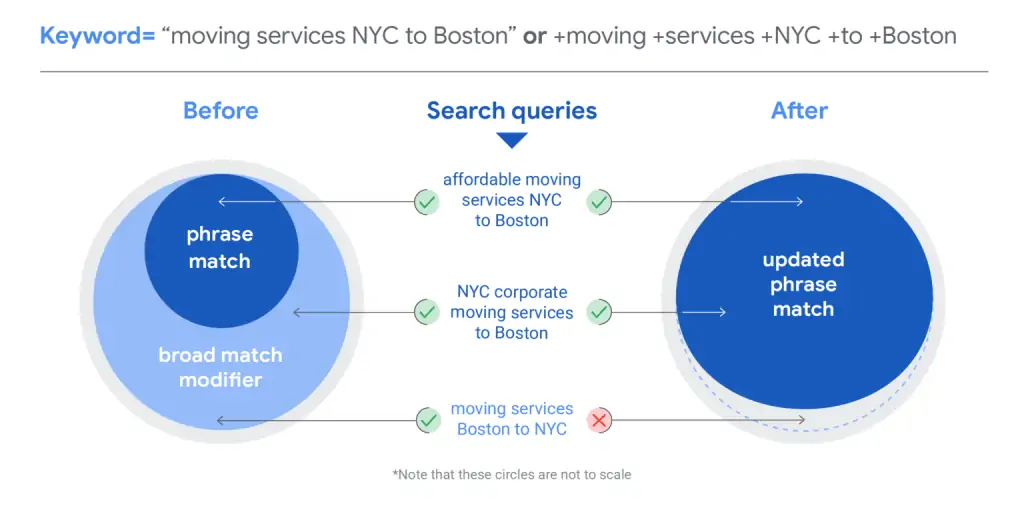
Photo courtesy of Google.
Why Should You Care?
This update from Google serves much of the same purpose that backs all their algorithm updates: better results returned for searches and automation. Consequently, this comes at the expense of the level of control on keywords matching for advertisers.
During the rollout period of the update, this would have signaled alarm bells for your SEO and PPC specialists, as traffic and other metrics see some drops. But now that these are fully integrated, and search engine marketing experts have recalibrated campaigns and reacclimated to this new SERP behavior, your business should focus on banking that data.
Maintain vigilance when monitoring patterns in your search performance so that you have data that can help you form insights for future campaigns. You wouldn’t want to have to start from scratch every time you execute a paid search campaign.
Key points to remember
This update, as much as it is an inconvenience, can prove to have a benefit for your business. Refining search results for users is a good thing for you too, because that means that if searchers come across your pages on SERP, they are more likely to click.
Ending up on the coveted top 10 still boils down to how strategic you are in terms of choosing and building associations with keywords that are relevant to your business. A best practice you can do to manage this is to go as specific as possible with your keywords and understanding your user’s search intent.
Conclusion
Indeed, that is a lot to take in for the first quarter of 2021, but keeping these news updates in mind should help put you on the right track to implementing a conversion-focused strategy-execution for your brand.
Do you think we missed out on something? Let us know! We’re always up for a good discussion. Hit us up at our Facebook, X, or LinkedIn accounts. We look forward to hearing from you!
